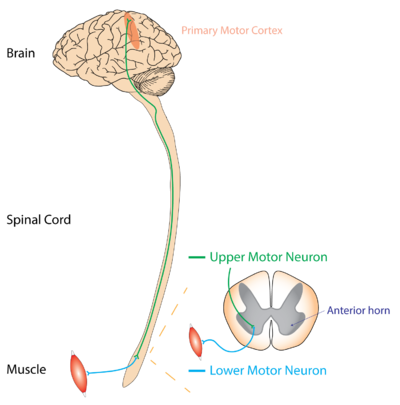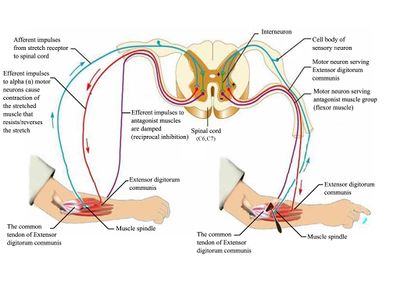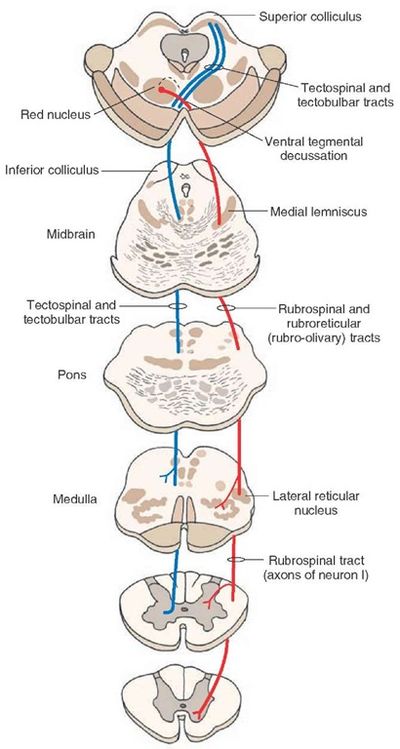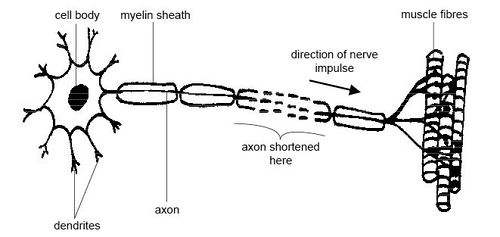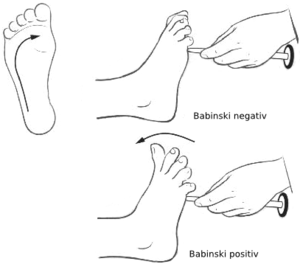Motor Neurone
Original Editor - Lucinda hampton
Top Contributors - Lucinda hampton, Rucha Gadgil and Naomi O'Reilly
Introduction[edit | edit source]
Motor neurones are cells in the brain and spinal cord that allow us to move, speak, swallow and breathe by sending commands from the brain to the muscles that carry out these functions. Their nerve fibers are the longest in the body, a single axon can stretch from the base of the spinal cord all the way to the toes.
Image: Corticospinal tract demonstrating distinction between upper motor neuron and lower motor neuron.
Motor neurons divided into either upper or lower motor neurones[1], forming various tightly controlled, complex circuits throughout the body. This controls both voluntary and involuntary movements through the innervation of effector muscles and glands. The upper and lower motor neurons form a two-neuron circuit.
- The upper motor neurons originate in the cerebral cortex and travel down to the brain stem or spinal cord
- The lower motor neurons begin in the spinal cord and go on to innervate muscles and glands throughout the body[2].
Upper and lower motor neurons utilize different neurotransmitters to relay their signals.
- Upper motor neurons use glutamate
- Lower motor neurons use acetylcholine.
Classes of Motor Neurones[edit | edit source]
Location:
- Upper motor neurons are either located in the cerebral cortex of the brain or the brain stem
- Lower motor neurons are located in the spinal cord, and their terminals extend all the way to the muscle fibers and tendons.
When complex motor operations are required, the lower motor neurons consult the upper motor neurons and both work in union to provide a meaningful response.
- Upper motor neurons are often consulted in case of voluntary motor responses. This is because, voluntary actions are backed by thoughts. For instance, you don’t walk just because you have to, you walk in the direction you wish to go; hence, the motor neurons of the brain have to be consulted in order to acquire coordination between thought and action.
- In case of reflexes, the nervous system has an automatic response mechanism; hence, the responses in this case are quicker than the former as there is no involvement of upper neurons.
Image: Relex arc
Upper Motor Neurone[edit | edit source]
An upper motor neurone exists in the brain and sends higher-level motor information to the medulla, located in the brain, or to the correct spinal cord level outside of the brain. From the medulla or the spinal cord, lower motor neurons carry motor information to muscle fibers, making them much more directly responsible for movement than upper motor neurons.
Upper motor neurones
- Reside in a couple of different parts the the brain.
- Generally concentrated in the motor region of the brain stem or cerebral cortex.
Image: Rubrospinal tract.
There are many different pathways down which an upper motor neuron can send electrical impulses that eventually translate to movement. Generally
- An upper motor neuron in the pyramid tract will have a role in controlling conscious movement. The pyramid tract begins in the cerebral cortex, specifically in the section of the frontal lobe that is known as the motor strip. In general, the nerve impulses travel from this motor strip to the spinal cord.
- An upper motor neuron in an extrapyramidal tract, or any pathway outside of the pyramid tract, will probably be involved in a subconscious motor process such as balance or posture. eg The rubrospinal tract is heavily involved in involuntary movements to improve and maintain the body's balance. Most of the movements relating to this tract occur in the arms; The tectospinal tract is related to the movements of the muscles in the neck; The reticulospinal tract has an important role in the control of autonomous actions in the body[3].
Lower Motor Neurone[edit | edit source]
The lower motor neuron is responsible for transmitting the signal from the upper motor neuron to the effector muscle to perform a movement. There are three broad types of lower motor neurons: somatic motor neurons, special visceral efferent (branchial) motor neurons, and general visceral motor neurons.
Somatic motor neurons are in the brainstem and further divide into three categories: alpha, beta, and gamma.
- Alpha motor neurons innervate extrafusal muscle fibers and are the primary means of skeletal muscle contraction. The large alpha motor neuron cell body can be either in the brainstem or spinal cord. In the spinal cord, the cell bodies are found in the anterior horn and thus are called anterior horn cells. From the anterior horn cell, a single axon goes on to innervate many muscle fibers within a single muscle. The properties of these muscle fibers are nearly identical, allowing for controlled, synchronous movement of the motor unit upon depolarization of the lower motor neuron.
- Beta motor neurons are poorly characterized, but it has been established that they innervate both extrafusal and intrafusal fibers.
- Gamma motor neurons innervate muscle spindles and dictate their sensitivity. These neurons primarily respond to stretch of the muscle spindle. Despite being named a “motor neuron,” these neurons do not directly cause any motor function. It is thought that they get activated along with alpha motor neurons and fine-tune the muscle contraction (alpha-gamma coactivation). A disruption in either alpha or gamma motor neurons will result in a disruption of muscle tone
Branchial motor neurons (or special visceral neurones) innervate the muscles of the head and neck that derive from the branchial arches (typically, six arches in vertebrates; in lower vertebrates, they bear gills; they are pharyngeal arches in human embryos).
- Located in the brainstem.
- The branchial motor neurons and sensory neurons together form the nuclei of cranial nerves V, VII, IX, X, and XI[2].
General visceral motoneurons contribute to both the sympathetic and parasympathetic functions of the autonomic nervous system.
- Directly involved in the contractions of the heart, the muscles of the arteries, and other viscera that are not consciously controlled[4].
Lesions[edit | edit source]
Snap your fingers or wiggle your toes. Those quick movements result from a sequence of electrical signals that begin in the brain. Motor neurons carry instructions from the brain along axons that stretch from the spinal cord to the muscles in the hands and feet. In diseases eg spinal muscular atrophy, motor neuron axons become damaged and degenerate, which means signals from the brain never reach the muscles and movement becomes impaired.
Upper and lower motor neuron lesions cause very different clinical findings.
- Upper motor neuron lesion are lesions anywhere from the cortex to the descending tracts. This lesion causes hyperreflexia, spasticity, and a positive Babinski reflex, presenting as an upward response of the big toe when the plantar surface of the foot is stroked, with other toes fanning out.
- Lower motor neuron lesions are lesions anywhere from the anterior horn of the spinal cord, peripheral nerve, neuromuscular junction, or muscle. This type of lesion causes hyporeflexia, flaccid paralysis, and atrophy.[2]
References[edit | edit source]
- ↑ The Conversation What we know, don’t know and suspect about what causes motor neuron disease Available from;https://theconversation.com/what-we-know-dont-know-and-suspect-about-what-causes-motor-neuron-disease-79409 (accessed 19.12.2020)
- ↑ 2.0 2.1 2.2 Zayia LC, Tadi P. Neuroanatomy, Motor Neuron. InStatPearls [Internet] 2020 Jan 24. StatPearls Publishing.Available from: https://www.ncbi.nlm.nih.gov/books/NBK554616/(accessed 20.12.2020)
- ↑ Wisegeek What is an Upper Motor Neuron? Available from:https://www.wise-geek.com/what-is-an-upper-motor-neuron.htm (accessed 20.12.2020)
- ↑ Wisegeek What is a motor neurone. Available from;https://www.wisegeek.com/what-is-a-motor-neuron.htm (accessed 20.12.2020)
